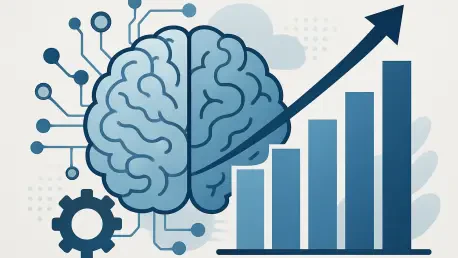In a world increasingly driven by data, the cognitive analytics market stands as a beacon of innovation, poised to redefine how industries harness information for strategic advantage. Valued at $3.9 billion in 2023, this transformative sector is on track to reach an astonishing $44.92 billion by 2032, propelled by a remarkable compound annual growth rate (CAGR) of 31.2%. This explosive growth underscores a fundamental shift in business operations, where artificial intelligence (AI) merges with analytics to emulate human reasoning, delivering real-time insights that fuel decision-making. From healthcare to finance, organizations are embracing cognitive analytics to navigate complex challenges, optimize processes, and gain a competitive edge in a fast-evolving landscape.
This technology, powered by machine learning (ML), deep learning, and natural language processing (NLP), goes beyond traditional data crunching by processing both structured and unstructured data—think spreadsheets alongside social media feeds—transforming raw information into actionable strategies. Retailers are personalizing customer experiences with unprecedented precision, while financial institutions detect fraud as it unfolds. The projected leap to nearly $45 billion in less than a decade signals not just market expansion, but a paradigm shift toward intelligent, adaptive systems. As businesses grapple with mounting data complexity, cognitive analytics emerges as a critical tool, promising speed, accuracy, and foresight in an era where every second counts.
Market Drivers and Growth Factors
AI as the Core Engine
The foundation of cognitive analytics lies in the unparalleled capabilities of AI, which equips systems to learn, reason, and predict outcomes with a level of accuracy that mirrors human cognition. Technologies like machine learning and natural language processing form the backbone, enabling platforms to sift through vast, diverse datasets and extract meaningful patterns. This capacity allows businesses to anticipate market trends, customer behaviors, and operational risks with remarkable precision. Unlike traditional analytics, which often lag behind real-time needs, AI-driven cognitive tools adapt continuously, refining their insights as new data emerges. This adaptability is particularly vital in dynamic sectors like finance and retail, where split-second decisions can determine success or failure.
Beyond prediction, AI enhances automation within cognitive analytics, streamlining complex processes that once required extensive human input. For instance, deep learning algorithms excel at interpreting unstructured data such as images or text, opening up applications in areas like medical diagnostics and sentiment analysis. This technological prowess not only boosts efficiency but also reduces errors, providing organizations with a reliable foundation for strategic planning. As AI continues to evolve, its integration into cognitive analytics platforms promises even greater sophistication, ensuring that businesses remain agile in the face of ever-changing demands and challenges.
Real-Time Decision-Making Demand
In today’s fast-paced business environment, the ability to make informed decisions instantly has become a non-negotiable asset for companies across industries. Cognitive analytics meets this urgent need by processing data on the fly, delivering insights that enable firms to respond to market shifts, customer preferences, and operational hurdles without delay. In sectors like finance, where stock market fluctuations demand immediate action, or retail, where consumer trends can pivot overnight, this real-time capability provides a distinct competitive advantage. The technology’s knack for identifying trends and anomalies as they happen ensures that businesses stay proactive rather than reactive.
Moreover, the emphasis on immediacy extends beyond mere speed to the quality of decisions. Cognitive analytics platforms integrate vast data streams—from transaction records to social media interactions—offering a holistic view that enriches strategic responses. This comprehensive approach helps organizations mitigate risks and seize opportunities in the moment, whether it’s adjusting pricing strategies or addressing supply chain disruptions. As the volume and velocity of data continue to grow, the demand for such instantaneous, data-driven decision-making tools is set to intensify, further cementing cognitive analytics as an indispensable resource for modern enterprises.
Cloud and Hybrid Dominance
Cloud-based solutions have emerged as a dominant force in the cognitive analytics market, thanks to their scalability, affordability, and ease of access, which democratize advanced tools for businesses of varying sizes. These platforms allow companies to process massive datasets without the burden of extensive on-site infrastructure, reducing costs while supporting remote and distributed workforces. The flexibility of cloud systems also means that organizations can scale their analytics capabilities up or down based on demand, a critical feature for seasonal industries or those experiencing rapid growth. This accessibility is driving widespread adoption, particularly among firms looking to modernize without breaking the bank.
Meanwhile, hybrid models, which combine the security of on-premises systems with the agility of cloud environments, are carving out a significant niche, especially in sectors handling sensitive data. Industries like healthcare and banking, where data privacy is paramount, benefit from hybrid setups that keep critical information secure while leveraging cloud resources for less sensitive operations. This balance addresses regulatory concerns while maintaining operational efficiency, fueling the segment’s rapid growth. As businesses increasingly prioritize both security and flexibility, the dominance of cloud and hybrid solutions is expected to shape the market’s trajectory through 2032, offering tailored pathways for diverse organizational needs.
Applications and Industry Impact
Customer Insights Leading the Way
Understanding customer behavior has become a cornerstone of business strategy, and cognitive analytics is at the forefront of this endeavor, providing tools to analyze preferences and patterns across multiple channels. By integrating data from social media, transaction histories, and customer relationship management (CRM) systems, these platforms enable companies to craft highly personalized experiences that resonate with individual consumers. In retail, for example, tailored marketing campaigns based on cognitive insights can significantly boost engagement and loyalty, turning casual shoppers into repeat customers. This focus on personalization is not just a trend but a fundamental shift in how businesses build lasting relationships.
The impact of customer insights extends beyond marketing to strategic decision-making at a broader level, and cognitive analytics helps uncover hidden trends in purchasing behavior, allowing firms to anticipate demand and adjust inventory or pricing accordingly. In banking, such insights facilitate targeted product offerings, ensuring that services align with client needs. This deep understanding of customer dynamics fosters trust and satisfaction, key drivers of long-term success. As competition intensifies across sectors, the ability to leverage cognitive tools for nuanced customer analysis is becoming a defining factor, positioning companies to thrive in crowded markets by delivering exactly what consumers want, when they want it.
Fraud Detection on the Rise
As digital transactions continue to surge, the need to combat cyber threats has propelled fraud detection to the forefront of cognitive analytics applications, making it the fastest-growing segment. These advanced systems excel at identifying unusual patterns and anomalies in real time, flagging potential fraud before it escalates into significant losses. In the financial sector, where online banking and e-commerce transactions are prime targets for malicious actors, cognitive analytics serves as a critical shield, analyzing vast volumes of data to detect irregularities that might indicate unauthorized activity. This proactive approach is transforming how businesses safeguard their operations and protect customer trust.
The sophistication of cognitive analytics in fraud detection lies in its ability to adapt to evolving threats, learning from each interaction to refine its detection algorithms. Unlike traditional methods that rely on static rules, these systems use machine learning to spot subtle deviations that could signal sophisticated scams, such as account takeovers or synthetic identity fraud. This dynamic capability is particularly crucial in e-commerce, where the speed of transactions leaves little room for manual oversight. By minimizing false positives and focusing on genuine risks, cognitive analytics not only enhances security but also improves operational efficiency, ensuring that legitimate transactions proceed without unnecessary delays.
Sector-Specific Solutions
Cognitive analytics is increasingly being tailored to meet the unique demands of individual industries, delivering solutions that address specific regulatory and operational challenges with precision. In healthcare, these tools are revolutionizing patient care by predicting outcomes, personalizing treatment plans, and even forecasting equipment failures to prevent downtime in critical settings. By analyzing electronic health records and real-time sensor data, cognitive platforms enable providers to deliver proactive interventions, improving patient outcomes while optimizing resource allocation. This targeted approach ensures compliance with strict regulations like HIPAA, balancing innovation with ethical considerations.
In the financial sector, cognitive analytics underpins risk assessment and algorithmic trading, where real-time data interpretation can mean the difference between profit and loss. Manufacturing, on the other hand, leverages predictive maintenance to enhance efficiency, using data from machinery sensors to anticipate breakdowns before they occur, thus minimizing costly interruptions. Retail benefits from inventory optimization and demand forecasting, aligning stock levels with consumer trends to avoid overstock or shortages. These tailored applications highlight the versatility of cognitive analytics, demonstrating its capacity to drive measurable returns on investment by addressing the specific needs of each sector, thereby accelerating adoption across diverse fields.
Regional Insights and Dynamics
North America’s Leadership
North America stands as the undisputed leader in the cognitive analytics market, driven by a robust technological infrastructure and the presence of industry giants that continuously push the boundaries of innovation. The United States, in particular, dominates with substantial investments in research and development, fostering an ecosystem where cutting-edge solutions are developed and rapidly adopted across sectors like healthcare and banking. Major players headquartered in the region set the pace for global trends, integrating cognitive tools into enterprise systems that shape how businesses operate. This technological maturity, coupled with a culture of early adoption, ensures that North America remains at the forefront of market expansion.
Canada, while smaller in market share, is emerging as a significant growth area within the region, fueled by government-backed initiatives to digitize healthcare and other public services. Investments in smart technology and data-driven policies are accelerating the adoption of cognitive analytics, particularly in medical research and patient management systems. This momentum is supported by a growing tech workforce and partnerships between public and private sectors, creating a fertile ground for innovation. As North America continues to lead, the interplay between established dominance in the U.S. and rapid progress in Canada illustrates a regional dynamic that balances scale with emerging potential, solidifying its position through 2032.
Asia Pacific’s Rapid Ascent
Asia Pacific is swiftly establishing itself as a powerhouse in the cognitive analytics arena, with countries like Japan and South Korea leading the charge through aggressive digital transformation strategies. Japan’s advanced technological infrastructure supports widespread adoption in finance and manufacturing, where automation and data-driven precision are priorities. South Korea, meanwhile, leverages investments in 5G and smart city projects to integrate cognitive analytics into urban planning and industrial applications. This regional focus on cutting-edge technology positions Asia Pacific as a hotbed of growth, with market expansion outpacing many other areas due to a collective emphasis on innovation.
Further amplifying this ascent, China and India contribute significantly through massive investments in AI and burgeoning digital economies that fuel demand for analytics solutions. China’s state-driven AI initiatives prioritize cognitive tools in sectors ranging from surveillance to e-commerce, while India’s growing IT sector and startup ecosystem drive adoption among small and medium enterprises. This blend of government support and private-sector dynamism creates a unique growth trajectory, characterized by rapid scalability and diverse applications. As digital infrastructure continues to expand, the Asia Pacific’s role as a high-growth region is set to challenge traditional market leaders, reshaping global dynamics in the cognitive analytics landscape.
Europe’s Balanced Approach
Europe carves out a distinctive path in the cognitive analytics market, balancing technological advancement with a strong commitment to ethical standards and data privacy. Countries like Germany and the UK lead the charge, with Germany’s strength in manufacturing driving the use of cognitive tools for industrial optimization and predictive maintenance. The UK, bolstered by a tech-savvy business environment, sees high adoption in financial services and public sector initiatives, where data-driven strategies enhance efficiency. This regional leadership is underpinned by a focus on innovation that aligns with societal values, ensuring that progress does not come at the expense of user trust.
Central to Europe’s approach is the influence of stringent regulations like the General Data Protection Regulation (GDPR), which shapes how cognitive analytics is deployed across industries. Companies must navigate strict guidelines on data usage, fostering the development of secure, transparent systems that prioritize user consent and protection. France adds to this dynamic with government-led AI initiatives and smart city programs, emphasizing public-sector applications that adhere to ethical frameworks. This careful balance between pushing technological boundaries and safeguarding privacy sets Europe apart, creating a model of adoption that could influence global standards as data security concerns grow, ensuring sustainable growth through responsible innovation.
Competitive Landscape and Innovation
Giants vs. Startups
The cognitive analytics market thrives on a vibrant competitive landscape, where established tech giants and agile startups each play pivotal roles in driving progress. Companies like IBM and Microsoft leverage their extensive resources and global reach to integrate cognitive analytics into comprehensive enterprise platforms, enhancing scalability for large organizations. IBM’s ongoing enhancements to its AI models and Microsoft’s development of intuitive data agents exemplify how these leaders embed cognitive tools into existing workflows, making adoption seamless for businesses already reliant on their ecosystems. This focus on broad, scalable solutions ensures that major players maintain a significant market presence.
In contrast, startups like Peak and Quantexa bring a fresh perspective, focusing on niche, industry-specific solutions that address targeted pain points with remarkable agility. Peak’s no-code platform empowers non-technical users to harness AI for demand forecasting in retail, while Quantexa’s contextual intelligence tools use graph analytics to tackle complex issues like financial fraud. These smaller entities often outpace larger competitors in flexibility, delivering customized offerings that resonate with specific sectors. The interplay between the scale of giants and the innovation of startups creates a dynamic market environment, fostering diversity in tools and approaches that ultimately benefit end-users across industries.
Technological Breakthroughs
Innovation remains the lifeblood of the cognitive analytics market, with continuous advancements in AI and related technologies reshaping what’s possible in data analysis. Recent developments in deep learning and in-memory computing have significantly reduced latency, enabling real-time analytics even when handling enormous datasets. These breakthroughs allow businesses to process information at unprecedented speeds, ensuring that insights are not only accurate but also timely. Graph analytics, which focuses on mapping relationships within data, is proving transformative in areas like fraud detection, uncovering hidden connections that traditional methods often overlook.
Additionally, visualization technologies, such as interactive dashboards and natural language query interfaces, are enhancing the accessibility of cognitive analytics for non-expert users. These tools translate complex data into clear, actionable insights, empowering decision-makers across departments to engage with analytics directly. The integration of advanced NLP capabilities, seen in platforms that allow conversational data interactions, further lowers the technical barrier, making powerful analytics available to a broader audience. As these technological strides continue, they promise to refine the precision and usability of cognitive systems, ensuring that businesses can tackle increasingly intricate challenges with confidence and efficiency.
Future Horizons and Strategic Implications
Overcoming Barriers to Adoption
Reflecting on the journey of cognitive analytics, the market has faced significant hurdles that have tested its resilience and adaptability over the years. Data privacy concerns have stood as a formidable barrier, with stringent regulations like GDPR imposing strict limits on how sensitive information can be handled. These challenges have compelled vendors to prioritize secure, compliant systems, embedding robust encryption and transparency features to protect user data. High implementation costs have also posed a persistent obstacle, often limiting access for small and medium-sized enterprises that have struggled to justify the upfront investment. Despite these issues, the industry has responded with innovative pricing models and cloud-based solutions to broaden accessibility.
Shaping Tomorrow’s Landscape
Looking ahead, the path forward for cognitive analytics involves strategic steps to sustain its remarkable growth trajectory. Businesses must continue investing in security measures to address lingering privacy concerns, ensuring compliance with evolving global standards while maintaining user trust. Collaboration between industry leaders and policymakers could help standardize ethical guidelines, fostering a safer environment for adoption. Additionally, expanding affordable, scalable solutions like subscription-based platforms will be crucial to include smaller firms in this technological revolution. As AI advances, focusing on intuitive, user-friendly interfaces will further democratize access, enabling diverse sectors to harness cognitive insights. These efforts, combined with a commitment to industry-specific customization, promise to solidify cognitive analytics as a cornerstone of future business strategy.









